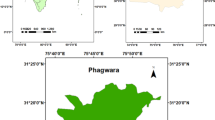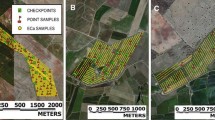Abstract
The information about water transmission rate into the ground is vital concerning the productivity of water system and seepage, advancing the accessibility of water for the plants, enhancing the yield of harvests, limiting degradation of soil and wastage of the water. Infiltration rate can successfully be measured using double ring infiltrometer. However, measurement of infiltration in the field is labour and time consuming and difficult especially in mountainous sites. As an alternative, RASP-based infiltration models can be developed. The study was carried out in the field near the NERIST campus (Nirjuli Complex), Arunachal Pradesh, India. Twenty sites were identified at the grid of 10 m interval, and the field measurement of infiltration was performed. The soil was analysed for properties, namely, soil texture, bulk density (BD), particle density (PD), moisture content (MC), and organic carbon content (OC) for each site. The basic infiltration varied from 1 to 4.84 cm/h. The Scatter plot between RASPs and infiltration rate revealed that there is a positive correlation with OC, PD, and sand, and a negative correlation with BD, MC, silt, and clay. The partial least square regression (PLSR) analysis was carried out to develop predictive models for five different groups of inputs of soil properties. The influential variable projection (VIPs) analysis revealed sand as a highly influential factor, while silt as a reluctant predictor of infiltration characteristics of the study site. It was found that to predict the soil infiltration rate based on RASPs with seven independent variables (Eq. 13) with coefficient of determination (R2) 0.92, root mean square error (RMSE) 0.378 cm/h, mean absolute error (MAE) 0.143 cm/h, and standard error (SD) 0.398 cm/h is strongly recommended for the prediction of infiltration characteristics.








Similar content being viewed by others
References
Abdi H (2010) Partial least squares regression and projection on latent structure regression (PLS Regression). WIREs Comput Stat 2:97–106
Abudu S, Cui CL, King JP, Moreno J, Bawazir AS (2011) Modelling of daily pan evaporation using partial least squares regression. Sci China Technol Sci 54(1):163–174. https://doi.org/10.1007/s1143.1-010-420.5-z
Arshad R, Sayad G, Mazlum M, Jafarnejadi A, Mohammadi Safarzadeh V (2010) Pedo transfer functions application to estimate the infiltration rate of the soil using neural network and linear regression methods. J Crop Improv 2(5):55–62
Clausnitzer V, Hopmans JW, Starr JL (1998) Parameter uncertainty analysis of common infiltration models. Soil Sci Soc Am J 62:1477–1487
Dabral PP, Pandey PK (2016) Models to estimate soil moisture retention limits and saturated hydraulic conductivity. J Indian Water Resour Soc 36(1):50–55
Ekhmaj AI (2010) Predicting soil infiltration rate using artificial neural network. In: 2010 International Conference on Environmental engineering and applications (ICEEA). IEEE, pp 117–121
Flint AL, Flint LE (2002) Particle Density. In: Dane JH, Topp CG (eds) Methods of soil analysis: part 4 physical methods, SSSA Book Ser. 5.4. SSSA, Madison, pp 229–240. https://doi.org/10.2136/sssabookser5.4.c10
Franzluebbers AJ (2002) Water infiltration and soil structure related to organic matter and Its stratification with depth. Soil Tillage Res 66:197–205. https://doi.org/10.1016/S0167-1987(02)00027-2
Gee GW, Or D (2002) Particle-size analysis. Methods of soil analysis. Part 4:255–293
Ghorbani-Dashtaki S, Araghi F, Mirlatifi M (2010) Soil cumulative infiltration prediction using PTFs in calcareous soil. J Water Soil Conserve 17(3):25–44
Ghorbani-Dashtaki S, Homaee M, Loiskandl W (2016) Towards using pedotransfer functions for estimating infiltration parameters. Hydrol Sci J 61(8):1477–1488. https://doi.org/10.1080/02626667.2015.1031763
Grossman RB, Reinsch TG (2002) Bulk density and linear extensibility. In: Dane JH, Topp CG (eds) Methods of soil analysis: part 4, physical methods SSSA Book Ser. 5.4. SSSA, Madison, pp 201–228
Huang M, Barbour SL, Elshorbagy A, Zettl JD, Si BC (2011) Infiltration and drainage processes in multi-layered coarse soils. Can J Soil Sci 91(2):169–183
Kashi H, Emamgholizadeh S, Ghorbani H (2014) Estimation of soil infiltration and cation exchange capacity based on multiple regression, ANN (RBF, MLP), and ANFIS models. Commun Soil Sci Plant Anal 45(9):1195–1213
Khatr KL, Smith RJ (2005) Evaluation of methods for determining infiltration parameters from irrigation advance data. Irrig Drain 54(4):467–482
Lake HR, Akbarzadeh A, Mehrjardi RT (2009) Development of pedo transfer functions (PTFs) to predict soil physicochemical and hydrological characteristics in southern coastal zones of the Caspian Sea. J Ecol Nat Environ 1(7):160–172
Mahdian M, Oskoee R, Kamali K, Angoshtari H, Kadkhodapoor M (2009) Developing Pedo Transfer Functions to predict infiltration rate in flood spreading stations of Iran. Res J Environ Sci 3(6):697–704
Martens H, Martens M (2000) Modified Jack-knife estimation of parameter uncertainty in bilinear modelling by partial least squares regression (PLSR). Food Qual Prefer 11:5–16
Mbagwu J (1994) Soil physical properties influencing the fitting parameters in Philip and Kostiakov infiltration models. International Centre for Theoretical Physics, Trieste
Mirzaee S, Zolfaghari AA, Gorji M, Dyck M, Ghorbani-Dashtaki S (2014) Evaluation of infiltration models with different numbers of fitting parameters in different soil texture classes. Arch Agron Soil Sci 60(5):681–693. https://doi.org/10.1080/03650340.2013.823477
Mousavi SB (2015) Employment of Pedo-transfer functions for predicting initial and finalInfiltration rates using horton model and soil readily available characteristics. Indian J Agr Sci 49(4):333–337. https://doi.org/10.5958/0976-058X.2015.00060.8
Nelson D, Sommers LE (1982) Total carbon, organic carbon, and organic matter. In: Page AL (ed) Methods of soil analysis. Part 2. Chemical and microbiological properties, Agron Monogr 9.2. ASA. SSSA, Madison, pp 539–579. https://doi.org/10.2134/agronmonogr9.2.2ed.c29
Osuji GE, Okon MA, Chukwuma MC, Nwarie II (2010) Infiltration characteristics of soils under selected land use practises in Owerri, Southeastern Nigeria. World J Agric Sci 6(3):322–326
Pandey V, Pandey PK (2010) Spatial and temporal variability of soil moisture. Int J Geosci 1(2):87–98
Pandey PK, Dabral PP, Kumar A, Kumar N (2009) Determination of physical, water retention and transmission properties of soil of paddy fields in the vicinity of Nirjuli (Arunachal Pradesh). J Soil Water Conserv (India) 8(4):3–10
Pandey V, Pandey PK, Mahanta AP (2014) Calibration and performance verification of Hargreaves–Samani equation in a humid region. Irrig Drain 63:659–667
Parchami-Araghi F, Mirlatifi SM, Dashtaki GS, Mahdian MH (2013) Point estimation of soil water infiltration process using artificial neural networks for some calcareous soils. J Hydrol 481:35–47
Parhi PK (2014) Another look at Kostiakov, modified Kostiakov and revised modified Kostiakov infiltration models in water resources applications. Int J Agric Sci 4(3):138–142
Perroux K, White I (1988) Designs for disc permeameters. Soil Sci Soc Am J 52(5):1205–1215
Punamia BC, Jain AK, Jain AK (2005) Soil mechanics and foundations (16th thoroughly revised and enlarged edition). Laxmi Pub. House, New Delhi, p 8170087910. ISBN: 9788170087915
Rahmati M (2017) Reliable and accurate point-based prediction of cumulative infiltration using soil readily available characteristics: a comparison between GMDH, ANN, and MLR. J Hydrol 551:81–91
Rashidi M, Hajiaghaei A, Amel-Sadeghi M (2013) Prediction of soil infiltration rate based on sand content of soil. Agric Eng Res J 3(2):20–24
Rawls WJ, Brakensiek DL, Miller N (1983) Green–Ampt infiltration parameters from soils data. J Hydraul Eng 109(1):62–70
Saleh I, Kavian A, Jafarian Z, Ahmadi R (2017) Estimation of final soil infiltration rate using fuzzy clustering algorithm, nero fuzzy (ANFIS) and fuzzy inference system (FIS) (a case study: Behshahr Plain, Galougah, Mazandaran, Iran). Appl Soil Res 4(2):47–59
Sarmadian F, Taaghizadeh-Mehrjardi R (2014) Estimation of the infiltration rate and deep percolation water using feed-forward neural networks in the Gorgan province. Eur J Soil Sci 3(1):1–6
Saxton KE, Rawls WJ (2006) Soil water characteristic estimates by texture and organic matter for hydrologic solutions. Soil Sci Soc Am J 70:1569–1578. https://doi.org/10.2136/sssaj2005.0117
Saxton KE, Rawls WJ, Romberger JS, Papendick RI (1986) Estimating generalized soil water characteristics from texture. Trans ASAE 50:1031–1035
Singer MJ, Munns DN (1999) Soils: an introduction, 4th edn. Prentice Hall, Upper Saddle River
Tuffour HO, Bonsu M (2015) Application of Green–Ampt equation to infiltration with soil particle phase. Int J Sci Res Agric Sci 2(4):076–088
U.S. Department of Agriculture (USDA) (1951) Soil survey manual, USDA agricultural handbook. No. 18. U.S. Government Printing Office, Washington, DC
Van de Genachte G, Mallants D, Ramos J, Deckers JA, Feyen J (1996) Estimating infiltration parameters from basic soil properties. Hydrol Process 10:687–701
Wold S (1995) PLS for multivariate linear modeling. In: van der Waterbeemd H (ed) Chemometric methods in molecular design: methods and principles in medicinal chemistry. Verlag-Chemie, Weinheim, pp 195–218
Wold S, Sjostrom M, Eriksson L (2001) PLS-regression: a basic tool of chemometrics. Chemometrics Intell Lab Syst 58:109–130
Wosten JHM, Van Genuchten MTH (1988) Using texture and other soil properties to predict the unsaturated soil hydraulic functions. Soil Sci Soc Am J 52:1762–1770. https://doi.org/10.2136/sssaj1988.03615995005200060045x
Author information
Authors and Affiliations
Corresponding author
Rights and permissions
About this article
Cite this article
Pandey, P.K., Pandey, V. Estimation of infiltration rate from readily available soil properties (RASPs) in fallow cultivated land. Sustain. Water Resour. Manag. 5, 921–934 (2019). https://doi.org/10.1007/s40899-018-0268-y
Received:
Accepted:
Published:
Issue Date:
DOI: https://doi.org/10.1007/s40899-018-0268-y




